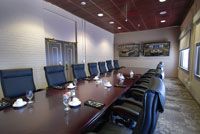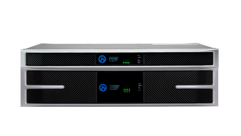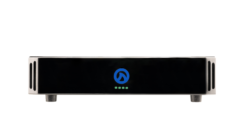

Smart Analog
Nov 17, 2011 10:12 AM,
By Steven Swift
Fort Leavenworth conference upgrade combines high tech with fiscal responsibility.
Frontier Conference Center
How do you cost-justify a complete remodeling of a federal facility in these days of trilliondollar deficits? You count your pennies and make sure every penny you spend gives you two cents worth of value. Such was the case at the Frontier Conference Center
(FCC) at Fort Leavenworth, Kan., which finished a major remodeling in May. Innovative AV systems designed by the Conference Technologies, Inc. (CTI) office in Kansas City ensured that the upgrade was fiscally conservative yet ready for future technologies.
Long overdue
No one could accuse the center’s managers of wasting taxpayers’ money on an unneeded upgrade. Built more than 50 years ago, the center averages 600 events each year involving tens of thousands of participants. It’s used extensively by the garrison for planning meetings, training, and retirement ceremonies, by officers as a social center, on a rental basis by local businesses, and by base personnel for weddings and parties. Soon the Army’s Command and General Staff College will begin using the center for classes and videoconferences.
The facility is now self-supporting. Revenues from room rentals and meals served in the center must pay for all maintenance, personnel costs, and other operating expenses.
“The new systems have definitely made the space much more competitive,” says Brett Wobker, the project manager for the upgrade and an engineer for the Directorate of Logistics at the fort.
Given the demand for meeting space and the potential for income, managers decided in 2010 that a major upgrade was in order. “We replaced the kitchen, upgraded the lighting, electrical, and HVAC, painted, replaced the carpeting, and installed AV systems for the first time,” Wobker explains. The systems are installed in 12 meeting spaces on two floors, including an ABC divisible ballroom with seating for up to 398 people, together with a master control room with centralized equipment racks.
Wobker says the goals for the new AV systems included the ability to show computer and video images in high definition, provide HD videoconferencing connectivity, support meetings and events with multiple presenters, support facility-wide digital signage and paging, and combine any or all of the AV systems into a single system supporting very large meetings and events.
Smart Analog
Nov 17, 2011 10:12 AM,
By Steven Swift
Fort Leavenworth conference upgrade combines high tech with fiscal responsibility.

Analog vs. digital
One reason FCC was able to afford the extensive AV systems was a decision to stay with analog versus digital audio and video signal transport.
The most important reason to install an all-digital system, according to Steve Martin, design consultant for CTI, would have been HDCP compliance, necessary to show
Blu-Ray movies and other consumer media in high definition. But that just wasn’t an issue in FCC.

Extron wall plate with component, S-Video, VGA, and audio inputs plus VGA monitor out.
Still, Martin and Don Otting, senior AV technician for the center, wanted to make sure that the facility would be ready for new laptops and other devices with digital HDMI outputs. Martin says that as long as HDCP copy protection is not an issue, there are several inexpensive converter boxes that will take an HDMI output and convert it to a VGA or component signal. “The quality will not be as high as it would be carrying the native digital signal, but the difference will be subtle,” he explains.
This is not to say that the center expects to stay with an analog system forever. “Our biggest concern,” Martin adds, “was making sure they had a cable plant that would handle 1080p video in native formats when they were ready to make that investment.”

The 64×64 Extron Cat-5 switcher, which routes any signal from any source to any combination of displays and sound systems in the facility.
Category cable
Martin says that, for the Frontier Conference Center, CTI purchased the very first MTPX Plus 64×64 Cat-5 matrix switcher shipped by Extron, and that made significant additional savings possible.
Cat-5e cable not only will able to handle 1080p digital video when the center is ready, but it is far less expensive to install than other cabling systems. Component and VGA cables use considerably more copper than twisted pair, are more expensive to manufacture, and require much larger conduits. It also takes considerably more labor to pull the heavier cables through that conduit and then terminate them.
In addition, the Extron switcher and Extron MTP transmitters and receivers make it possible to carry an RS-232 signal on the Cat-5e cable, avoiding the need to purchase and install a separate set of serial cables for the AMX control system. The Extron MTP transmitters also have EDID minders built in, so EDID compliance—an issue today for many analog systems—is not a problem.
Martin estimates FCC may have saved as much as 25 to 30 percent of the cost of the entire AV system by using Category cable and the Extron components.
Smart Analog
Nov 17, 2011 10:12 AM,
By Steven Swift
Fort Leavenworth conference upgrade combines high tech with fiscal responsibility.
Advanced features

Digital signage monitor outside the ballroom shows the day’s schedule.
Otting, who has worked in meeting support for more than 20 years, says the new FCC systems are the most advanced he has ever seen.
“The video is crystal clear, the audio is unbelievably clean, and it’s user-friendly. I can set up the AV for a major conference by myself,” he explains.
According to Otting, by putting virtually all of the system components into a master control room, Martin and CTI made it possible for a single technician to support the multiple meetings typically going on at the center. A 17in. AMX Modero touchpanel in the control room gives Otting the ability to operate every system in the facility, switching inputs, dialing videoconferences, even adjusting the gain on microphones.
In addition, 12 7in. AMX touchpanels give presenters basic controls over individual systems, and a password-protected technician’s page on each gives Otting the ability to finetune the systems. “We also have a wireless AMX panel, which I can take from room to room during setups or use for close support of an important meeting,” Otting explains.
The 64×64 matrix switcher allows Otting to route any signal from any source to any combination of displays and sound systems in the facility, allowing very flexible overflow for large meetings. Otting can also route cable TV programming into the lobby or meeting rooms, which he does frequently for social events.
The ballroom includes an ABC room-combining audio and video system, with individual
Panasonic projectors and Da-Lite screens on the north walls serving each section and a larger projection system on the east wall serving the combined room. The room-combining and other audio functions are handled by seven Biamp AudiaFlex processors.
CTI installed two Polycom HDX8000 videoconferencing systems, one in the ballroom and one in the 20-seat Centennial Room (shown on this issue’s cover), together with Polycom EagleEye HD cameras. There’s an additional Polycom system on a rolling cart, which can plug into any of the other meeting rooms and combine with the center’s AV and control systems.
Another rolling cart delivers a Mackie 16-channel mixer and 100ft. snake to any meeting room. Otting uses it mainly to mix microphones for events with multiple presenters or speakers. Seven wireless mics can be assigned individually to a particular room from any of the technicians’ touchpanels. A ClearCom Tempest wireless intercom system allows up to three technicians to communicate during larger events.
A facility-wide paging system extends into every meeting room, hallway, kitchen, and nearby outdoor area, making it easy to reach any officer or address any group should there be a major or minor emergency.
There’s also a digital signage system, powered by a KeyWest MediaZone server, which can send messages to an LCD panel in the lobby, another outdoors, and to each of the meeting rooms. The outdoor system uses a 55in. LG LCD display in an iTech environmental enclosure.
Still have their place
As conservative as FCC managers have been with their capital and operating budgets, they are very pleased with the capabilities they have been able to add. “The more I work with the AV system, the more I am amazed at all the features it has,” Otting explains.
“The other day, for example, I set up 16 microphones on a U-shaped table. Some of the generals are a little older and don’t speak very loud. I was able to leave all the mics live and adjust the gain for each individually, with absolutely no trace of feedback.”
“Analog systems still have their place,” Martin adds. “When thoughtfully designed, they can provide exceptional value and outstanding service for many years to come.
Steven Swift is a freelance writer based in Des Plaines, Ill. Images: Pamela Kudlacek of Conference Technologies










